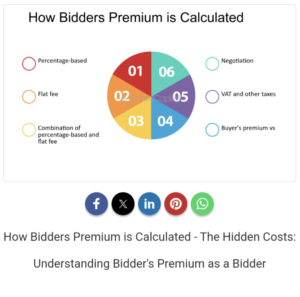Table of Contents
If you’re thinking about jumping into tax lien investing, you’re probably excited about the potential returns—but maybe a little confused by the tax lien sale auction process, all the bidding methods, and auction rules.
Don’t worry, I’ve been there too.
Tax lien investing can seem complex at first, but once you get a handle on the different bidding methods and how the auction process works, you’ll feel a lot more confident.
Let’s break it down, nice and easy.
How Tax Lien Auctions Work
Here’s the deal: when property owners don’t pay their property taxes, the government wants to collect those taxes.
So, they sell tax liens—which are basically a claim to collect that unpaid tax—from the property owner.
As an investor, you bid at an auction to buy those liens.
If you win the bid, you essentially pay the back taxes.
The property owner then has a certain amount of time (the redemption period) to pay you back, plus interest.
If they don’t pay, you could eventually foreclose on the property and own it outright.
So, in a nutshell: you’re either making money from the interest on the lien, or you’re getting a property.
Either way, you win.
But here’s the kicker—how much you win depends on how smartly you bid.

Premium Bid Method
The premium bid method is the most common type of tax lien auction.
In this method, you bid above the amount of back taxes owed, and the highest bid wins the lien.
Let’s say the back taxes are $1,000, but you bid $2,000. That extra $1,000 is the “premium.”
Why It Matters: The catch with premium bidding is that the premium usually doesn’t earn interest or get refunded.
So, if you bid too high, you’re eating into your potential profits.
For example, if the property owner pays the back taxes quickly, you won’t have enough time to earn much interest, and you’ll be stuck with the premium you paid.
Pro Tip: Always set a maximum bid before the auction, based on how long you expect the lien to stay unpaid.
If you think the owner will pay back quickly, don’t bid too high.
If it looks like the lien will stick around for a while, you might feel safer bidding a little more.

Image Credit: https://fastercapital.com/topics/how-bidders-premium-is-calculated.html
Other Bidding Methods You Might See
Depending on where you’re bidding, you might come across some other methods.
Let’s look at the most common ones:
- Bid Down Interest Rate
In this method, everyone bids on how low of an interest rate they’re willing to accept. The person willing to take the lowest interest wins.
For example, if the starting rate is 18%, but someone bids 6%, they win the lien—but they’re only earning 6% interest.
- Tip: Be cautious here. If you bid the rate too low, your profit margin shrinks. Do the math on whether it’s worth winning the lien if you’re barely making anything from it.
- Rotational Bidding
This is pretty straightforward. The auctioneer goes down a list of bidders, giving each person a chance to buy a lien in turn.
You can either take the lien or pass, and they move to the next bidder. It’s slow, but it’s fair—nobody can outbid you.
- Tip: Rotational bidding is good for small investors since you aren’t competing directly with others. But you need to be patient and selective about which liens you choose.
- Random Selection
Like a lottery. The auctioneer randomly picks a bidder to accept or reject a lien. If they reject it, the next bidder is chosen at random until someone takes the lien.
It’s totally luck-based, so it’s hard to strategize for this one.
- Tip: If you’re in a random selection auction, just be sure to have a clear idea of which properties you want and which you don’t. Don’t get stuck with a bad lien because you feel pressured to buy.
- Ownership Bidding
This is less common but can be interesting. Instead of bidding down the interest rate, you’re bidding for partial ownership of the property.
The bidder willing to take the smallest share of ownership wins the lien.
- Tip: Be careful with this one. If you don’t own the full property, it can be tricky to foreclose. You could be left with a lien you can’t act on.
Bidding Method | Pros | Cons |
|---|
Premium Bidding | – High competition can lead to profitable returns | – Premium often doesn’t earn interest |
|---|
– Allows for quick decision-making in fast auctions | – Overbidding can eat into profits |
|---|
– In some states, premium is refundable on redemption | – May require significant upfront capital |
|---|
Bid Down Interest Rate | – Easier to calculate potential profit | – Lower interest rates reduce potential returns |
|---|
– Bidders know their exact interest rate from the start | – High competition can lead to near-zero interest |
|---|
– No premium means less upfront capital required | – Corporate bidders may drive down rates quickly |
|---|
Rotational Bidding | – Fair and systematic bidding | – Slower process compared to other methods |
|---|
– Good for smaller auctions or small investors | – Less competitive pricing; may miss out on deals |
|---|
– Lower risk of overbidding or losing to large competitors | – Limited flexibility in bidding on preferred liens |
|---|
Random Selection | – Equal chance for all bidders | – Luck-based; no control over which liens you can bid on |
|---|
– No bidding wars; reduces chance of overbidding | – Could result in missing out on high-value properties |
|---|
– Allows for more strategic selection of liens | – Hard to prepare a bidding strategy |
|---|
Ownership Bidding | – Potentially attractive interest rates | – Partial ownership may limit foreclosure rights |
|---|
– May secure a partial ownership stake in the property | – Difficult to sell or profit from partial stakes |
|---|
– Less competition in auctions using this method | – Higher risk; less control over property outcomes |
|---|
Choosing Your Bidding Strategy
The type of auction you’re in will determine how you should bid, but here’s what stays the same: always know your limits.
Whether you’re dealing with a premium bid auction or bidding down the interest rate, you don’t want to bid yourself out of a profit.
Ask yourself: How much interest can I realistically expect to earn before the lien is redeemed?
How much of a premium can I afford to pay without eating up all my profits?
How to Calculate Your Bid in a Premium Auction
In a premium bid auction, the key is to know your maximum bid.
Here’s a simple way to think about it:
- Check the lien amount: This is the base amount of back taxes owed.
- Estimate how long the lien will stay unpaid: If the property owner is likely to redeem it quickly, your interest will be lower. If they don’t, you’ll earn more interest.
- Factor in the premium: The premium you bid doesn’t earn interest, so be cautious about how high you go. You don’t want to bid so high that the premium eats up your potential earnings.
Example: If the lien amount is $1,000 and you think the lien will be unpaid for 12 months at 10% interest, you’re looking at a $100 profit.
If you bid a $500 premium, that profit shrinks to $100 minus $500—you’re now in the hole by $400.
Tip: Set a hard maximum bid before the auction starts. Calculate how much you’re willing to pay over the lien amount and stick to it.
Auctions can get competitive, and it’s easy to get swept up in the moment, but always bid with your head, not your heart.
Post-Auction: What Happens Next?
Once you win a lien, your job isn’t over.
There are a few key things to keep in mind after the auction:
- Monitor the Redemption Period: The property owner has a specific amount of time (varies by state) to pay back the taxes plus interest. During this time, you’re just waiting to see if they redeem the property or not.
- Collect Interest: If they redeem, you’ll get the lien amount back plus any interest you’ve earned. Make sure you’re keeping track of deadlines and payments. In some states, the premium is refunded, but this isn’t always the case, so know your state’s rules.
- Foreclosure: If the property owner doesn’t redeem the lien within the redemption period, you can start the foreclosure process to take ownership of the property. This is a bigger commitment and involves legal steps, so make sure you’re prepared for this possibility.

Risks to Watch Out For
Tax lien investing isn’t without risks, so keep these potential pitfalls in mind:
- Overbidding: The biggest mistake is getting caught in a bidding war and paying more than the lien is worth. Remember, your premium doesn’t earn interest, so don’t get stuck with a big upfront payment and minimal returns.
- Bad Liens: Always do your homework before bidding. Research the properties tied to the liens—some might be worthless or impossible to sell later on. You don’t want to end up foreclosing on a property nobody wants.
- Foreclosure Costs: If you end up having to foreclose, it can be expensive and time-consuming. Make sure you’re ready for that possibility before bidding, especially if you’re eyeing properties in foreclosure-prone areas.

Final Tips for Success
- Do Your Research: Always look into the property behind the lien. Make sure it’s in good condition, in a decent location, and worth the risk of foreclosure.
- Set Your Limits: Know your maximum bid before the auction and don’t go over it, no matter how competitive the bidding gets.
- Understand Local Rules: Tax lien auctions differ by state, so make sure you know the specific rules for bidding, premiums, and redemption in your target area.
Tax lien investing can be a profitable venture if you approach it smartly.
Stick to your strategy, do your homework, and you’ll set yourself up for success.
Finally, I believe the best way I’ve found to learn is by doing and “failing forward” as they say.
I bought my 1st investment property in 2020 during the middle of (you know what..cough..cough), and I had no clue what I was doing despite spending months researching how to invest in real estate.
But guess what? I did it.
And learned a ton of valuable lessons along the way!
So,If you’re truly interested in tax lien investing, consider subscribing to my newsletter and following along my journey from landlord to “leinlord” as a new tax lien investor.
As Leinlord grows, my goal is to provide a “behind the scenes” inside look at the tax lien auctions I participate in and thoroughly profile any properties that I win.
You’ll get to ride along with me as I walk through my risk analysis, deal structures, ROI calculations, bidding tactics, and exit strategies all documented for the world to see (even my L’s).
So please show your support and sign up for my newsletter OR if you are a Google Chrome user hit that “follow” button!
(screenshot instructions found on my about page:))
Additionally, if you’re interested in booking a consultation to talk tax lien strategy feel free to schedule a one-on-one here.
P.S. I am still fairly new to tax lien investing but willing to share what I’ve learned so far, so please keep that in mind before you book!
I’m not an expert… (yet)
Look forward to having you in the Leinlord community!
**Disclaimer
I am not a lawyer, financial advisor, or tax professional. This article is based on my personal research and experience as a tax lien investor. The information provided is for educational purposes only and should not be considered legal, financial, or tax advice. Always consult with qualified professionals before making any investment decisions or taking action related to tax liens. Laws and regulations vary by jurisdiction and can change over time, so verify all information independently. Investing in tax liens carries risks, and past performance does not guarantee future results.


![Read more about the article Baldwin County, AL Tax Lien Sale Breakdown [A-Z Guide]](https://leinlord.com/wp-content/uploads/2024/09/word-image-1246-1-200x300.jpeg)

![Read more about the article Navigating The Autauga County, AL Tax Lien Sale: [A-Z Guide]](https://leinlord.com/wp-content/uploads/2024/09/word-image-1220-1-300x200.jpeg)